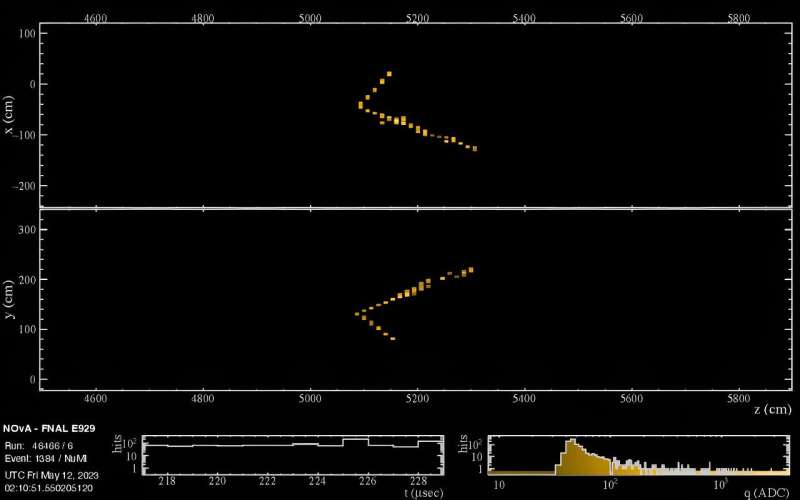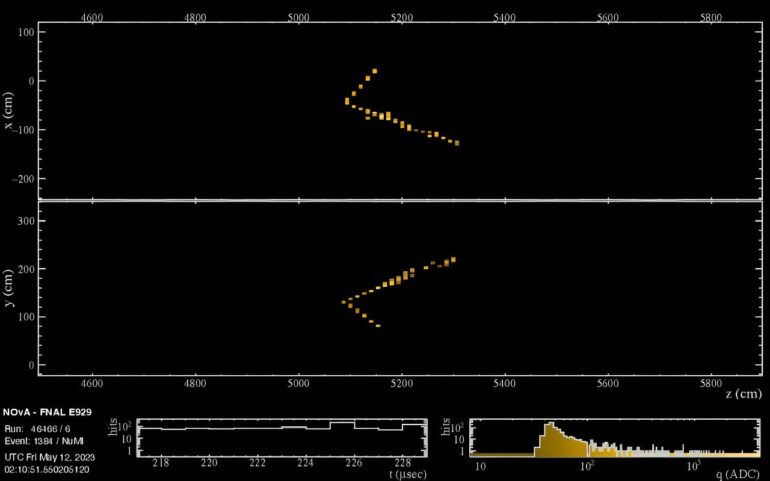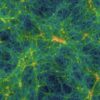The international NOvA collaboration presented new results at the Neutrino 2024 conference in Milan, Italy, on June 17. The collaboration doubled their neutrino data since their previous release four years ago, including adding a new low-energy sample of electron neutrinos.
The new results are consistent with previous NOvA results, but with improved precision. The data favor the “normal” ordering of neutrino masses more strongly than before, but ambiguity remains around the neutrino’s oscillation properties.
The latest NOvA data provide a very precise measurement of the bigger splitting between the squared neutrino masses and slightly favor the normal mass ordering. That precision on the mass splitting means that, when coupled with data from other experiments performed at nuclear reactors, the data favor the normal ordering at almost 7:1 odds.
This suggests that neutrinos adhere to the normal ordering, but physicists have not met the high threshold of certainty required to declare a discovery.
NOvA, short for NuMI Off-axis νe Appearance, is an experiment managed by the U.S. Department of Energy’s Fermi National Accelerator Laboratory, located outside of Chicago.
Fermilab sends a beam of neutrinos 500 miles north to a 14,000-ton detector in Ash River, Minnesota. By measuring the neutrinos and their antimatter partners, antineutrinos, in both locations, physicists can study how these particles change their type as they travel, a phenomenon known as neutrino oscillation.
NOvA aims to learn more about the ordering of neutrino masses. Physicists know that there are three types of neutrinos with different masses, but they don’t know the absolute mass, nor which is heaviest.
Theoretical models predict two possible mass orderings, normal or inverted. In the normal ordering, there are two light neutrinos and one heavier neutrino; in inverted, there is one light neutrino and two heavier ones.
“Getting additional information from reactor experiments enhances our knowledge of the mass ordering and gets us close to exciting territory,” said Erika Catano-Mur, a postdoctoral research associate at William & Mary and co-convener of the analysis. “We almost have an answer to one of those big questions that we have in neutrino physics. But we’re not there yet.”
The solution to neutrino oscillation remains ambiguous in the new results. Physicists don’t currently have enough data to disentangle two effects on the oscillation: mass ordering and a property called charge parity violation.
The collaboration observed a moderate amount of oscillation that could be explained in either mass ordering scenario with different amounts of CP violation, so they cannot tease apart the mass ordering and CP violation. However, the physicists were able to rule out specific combinations of the two properties.

An electron neutrino scattering event from the latest NOvA dataset. The brighter the yellow pixels, the more energy that was deposited. Physicists know this is a neutrino because it occurs in time with the beam pulse, “points” back to Fermilab, and occurs far away from the edges of the detector, meaning whatever initiated the activity had to travel through a lot of matter without leaving a trace. The electron in the final state is initially track-like, but then develops into an electromagnetic cascade. © NOvA Collaboration
“It really takes more than one measurement for us to learn everything we need to know,” said Jeremy Wolcott, a postdoctoral fellow at Tufts University, one of NOvA’s analysis coordinators and the speaker at the conference.
“NOvA is an important player in this because there are unique aspects to all of the various experiments that are trying to measure the same parameters,” said Wolcott. “We’re starting to see a picture come together, but it’s murky. Having different measurements that all work together is really important.”
The NOvA experiment started taking data in 2014 and will continue running through early 2027, during which time the collaboration hopes to double their antineutrino dataset. They also continue to implement analysis improvements to maximize the sensitivity of the experiment.
Their efforts are also paving the way for future experiments that will seek to contribute even more to solving the mysteries around neutrino properties.
“We want to make the most that we can out of the data,” said Catano-Mur. “What we learn—not only from the results themselves, but in the process, what we’re learning about the analysis methods—is going to be useful for the next generation of experiments that right now are under construction.”
Still, NOvA has the potential to reveal more about the elusive neutrino. “This result is an important reminder that the current generation of experiments, including NOvA, continues to collect valuable data and produce physics insights,” said Zoya Vallari, postdoctoral researcher at CalTech and co-convener of the analysis. “They are our best shot at a discovery right now.”
The NOvA collaboration is made up of more than 200 scientists from 50 institutions in eight countries. With the additional data and further analysis improvements, NOvA will bring physicists closer to understanding the identity-changing behavior of neutrinos.
Provided by
Fermi National Accelerator Laboratory
Citation:
New NOvA results add to mystery of neutrinos (2024, June 28)



